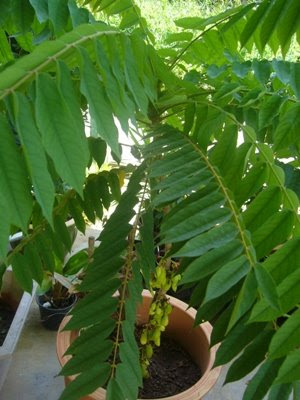When we came back from our short trip from Kuala Lumpur last August, I noticed some flowers around the tiny stem of the plant. My assumption was, perhaps due to the lack of water (been away for a week), the humid hot weather will actually trigger most plants to produce blooms. After a week, I noticed that the flowers withered and small fruits appeared. I just can't believe it that my Belimbing Buluh tree or should I still consider it a plant is actually bearing normal size fruits. Uummm, it's really unexpected from such a small plant but I will pluck them in no time to add to my sambal, vegetable dalca or acar buah that I'm planning to cook.


Why I still consider it a plant and not a tree?? The height of the plant is not even a metre tall considering it can actually reach to the height of 5 mtrs to 10 mtrs tall upon maturity. Furthermore, I bought the seedling, planted in a black polybag at the local Sunday market around 6 months ago for a mere $3 in local currency.
The Belimbing Buluh is a local favorite plant/tree and is a close relative of the Carambola or popularly known as the Starfruit. Botanically the Belimbing Buluh is known as Averrhoa Bilimbii and it is also known as the Cucumber tree, Blimbling, Tree Sorrel and many other names. Apparently it originated from the Molluccas, Indonesia and the species is mostly cultivated or found semi-wild throughout Indonesia, Phillippines, Sri Lanka, Bangladesh & Myanmar. It is also commonly found in other Southeast Asian countries. It is considered a tropical tree, less resistant to cold if compared to the Carambola (Starfruit).
The plant is considered long-lived, can reach up to the height between 5 mtrs to 10 mtrs tall with the short trunk quickly divided into upright branches. The oblong 11 to 37 leaflets are alternately arranged in a cluster on a long stem about 30cm to 60cm long. The dark-red flowers, appearing in panicles, bloom from the trunk and oldest branches, are small and fragrant and often in great number towards the bottom of the tree. Bright-green fruits follow,5cm to 8cm in length, often in clusters and a single tree often produces hundreds and hundreds of fruits. The fruits of the Belimbii which is very sour compared to the Carambola (Starfruit) are often added onto some of the Malay cuisines such as Sambal dishes, curry dishes & others.

The fruit is traditionally used to help those suffering from high blood pressure and from high fever. For treating high blood pressure sufferers, the fruits are blended, drained to obtain just the juice and drink either in the morning or night. If prefer, sweeteners can be added to the juice since the juice by itself is bitter. The leaves are washed, hand crushed and put onto a piece of cloth which is then put or leave on the forehead to relieve high fever. In some parts of Malaysia the leaves of bilimbi are used as a treatment for venereal disease. A leaf decoction* is taken as a medicine to relieve rectal inflammation. It also seems to be effective against coughs and thrush.
Propagation is by seeds from the ripe fruits or by grafting from a strong, matured stem. This plant grows well in rich, well-drained medium (also stands limestone & sand).
**decoction - extraction by boiling, essence obtained
Since the Eid festivities is just around the corner, I've added Hari Raya songs in my playlist for your listening pleasure. Enjoy!
Saturday, September 20, 2008
Can't believe it! It fructify.....
Labels:
Fruit Tree,
Local Favourite,
Others
Subscribe to:
Post Comments (Atom)













1 comment:
Thanks Chris for your supportive comments and I'm glad that you like my blog. Be sure to visit your blog one of these days.
Post a Comment